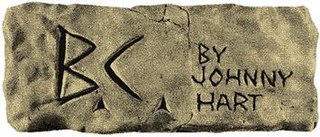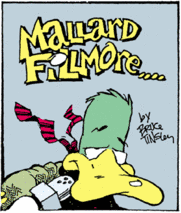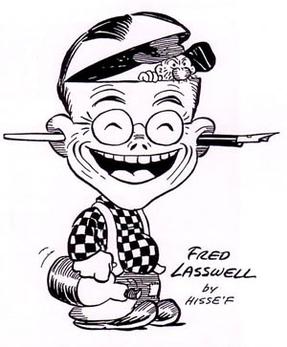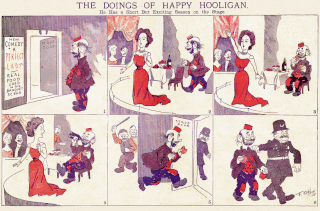Related Research Articles

A comic strip is a sequence of cartoons, arranged in interrelated panels to display brief humor or form a narrative, often serialized, with text in balloons and captions. Traditionally, throughout the 20th and into the 21st century, these have been published in newspapers and magazines, with daily horizontal strips printed in black-and-white in newspapers, while Sunday papers offered longer sequences in special color comics sections. With the advent of the internet, online comic strips began to appear as webcomics.

Peanuts is a syndicated daily and Sunday American comic strip written and illustrated by Charles M. Schulz. The strip's original run extended from 1950 to 2000, continuing in reruns afterward. Peanuts is among the most popular and influential in the history of comic strips, with 17,897 strips published in all, making it "arguably the longest story ever told by one human being". At the time of Schulz's death in 2000, Peanuts ran in over 2,600 newspapers, with a readership of roughly 355 million across 75 countries, and had been translated into 21 languages. It helped to cement the four-panel gag strip as the standard in the United States, and together with its merchandise earned Schulz more than $1 billion. In 2015, a movie adaptation was released by Blue Sky Studios.
Marvin, later called Marvin & Family, is a daily newspaper comic strip created by cartoonist Tom Armstrong and distributed in the U.S. by Hearst's King Features Syndicate. Debuting in 1982, it revolves around the life and times of a young baby boy named Marvin, along with his parents, Jeff and Jenny Miller, and their dog Bitsy. In 1989, CBS aired a special, "Marvin, Baby of the Year."

Pearls Before Swine is an American comic strip written and illustrated by Stephan Pastis. The series began on December 31, 2001. It chronicles the daily lives of an ensemble cast of suburban anthropomorphic animals: Pig, Rat, Zebra, Goat, and a fraternity of crocodiles, as well as a number of supporting characters, one of whom is Pastis himself. Each character represents an aspect of Pastis's personality and worldview. The daily and Sunday comic strip is distributed by Andrews McMeel Syndication.
Funky Winkerbean was an American comic strip by Tom Batiuk. Distributed by North America Syndicate, a division of King Features Syndicate, it appeared in more than 400 newspapers worldwide.

Rex Morgan, M.D. is an American soap opera comic strip, created May 10, 1948 by psychiatrist Dr. Nicholas P. Dallis under the pseudonym Dal Curtis.

King Features Syndicate, Inc. is an American content distribution and animation studio, consumer product licensing and print syndication company owned by Hearst Communications that distributes about 150 comic strips, newspaper columns, editorial cartoons, puzzles, and games to nearly 5,000 newspapers worldwide. King Features Syndicate also produces intellectual properties, develops new content and franchises, and licenses its classic characters and properties.

B.C. is a daily American comic strip created by cartoonist Johnny Hart. Set in prehistoric times, it features a group of cavemen and anthropomorphic animals from various geologic eras.

Henry is a comic strip created in 1932 by Carl Thomas Anderson. The title character is a young bald boy who is mostly mute in the comics. Except in a few early episodes, when the comic strip character communicates, he does so largely but not entirely through pantomime. He also spoke in a comic book series of 1946–1961 and in at least one Betty Boop cartoon from 1935 in which Betty Boop has a pet shop and Henry speaks to a dog in the window.

Seymour "Sy" Barry is an American comic-book and comic-strip artist, best known for being the artist of the strip The Phantom for more than three decades.

Mallard Fillmore is a comic strip written and illustrated by Bruce Tinsley until 2019 and Loren Fishman since 2020. It has been syndicated by King Features Syndicate since June 6, 1994. The strip follows the exploits of its title character, an anthropomorphic green-plumaged duck who works as a politically conservative reporter at fictional television station WFDR in Washington, D.C. Mallard's name is a pun on the name of the 13th president of the United States, Millard Fillmore.

Fred D. Lasswell was an American cartoonist best known for his decades of work on the comic strip Barney Google and Snuffy Smith.

The Little King is an American gag-a-day comic strip created by Otto Soglow, which ran from 1930 to 1975. Its stories are told in a style using images and very few words, as in pantomime.

Henry Boltinoff was an American cartoonist who worked for both comic strips and comic books. He was a prolific cartoonist and drew many of the humor and filler strips that appeared in National Periodical comics from the 1940s through the 1960s.

Mark Tatulli is an American cartoonist, writer, animator and television producer, known for his strips Liō and Heart of the City and for his work on the cable reality television series Trading Spaces and A Wedding Story, for which he has won three Emmy Awards. His comics have appeared in hundreds of newspapers around the world.
Raymond Curtis Billingsley is an African American cartoonist, best known for creating the comic strip Curtis. It is distributed by King Features Syndicate and printed in more than 250 newspapers nationwide.

Happy Hooligan is an American comic strip, the first major strip by the already celebrated cartoonist Frederick Burr Opper. It debuted with a Sunday strip on March 11, 1900 in the William Randolph Hearst newspapers, and was one of the first popular comics with King Features Syndicate. The strip ran for three decades, ending on August 14, 1932.
A comic strip syndicate functions as an agent for cartoonists and comic strip creators, placing the cartoons and strips in as many newspapers as possible on behalf of the artist. A syndicate can annually receive thousands of submissions, from which only two or three might be selected for representation. In some cases, the work will be owned by the syndicate as opposed to the creator. The Guinness World Record for the world's most syndicated strip belongs to Jim Davis' Garfield, which at that point (2002) appeared in 2,570 newspapers, with 263 million readers worldwide.
Todd the Dinosaur written and drawn by Patrick Roberts, is an American gag-a-day comic strip about a 7 year old Tyrannosaurus attending elementary school. Being only second graders, his classmates accept Todd as they would anyone else. The strip first appeared in 2001 in The Oklahoman and is published by King Features Syndicate. It has also appeared in Record-Journal, Herald News and San Francisco Chronicle. It participated in the second Earth Day comic event of King Features. During one day, 37 of their creators used their comics to advance an environmental theme.
Quincy is an American syndicated newspaper comic strip published from July 13, 1970 to October 4, 1986, created and produced by cartoonist Ted Shearer. The series, about an African-American boy being raised by his grandmother in Harlem, was one of the earliest mainstream comic strips to star an African American in the lead role, following Dateline: Danger! (1968-1974) and Luther (1969-1986). Another predecessor, Wee Pals, features an African-American among an ensemble cast of different races and ethnicities.
References
- ↑ Dean Mullaney, Bruce Canwell and Brian Walker, King of the Comics : One Hundred Years of King Features Syndicate. San Diego : IDW Publishing, 2015. ISBN 9781631403736 (p. 259)
- ↑ "Editor's Dispatch: A Conversation with Ray Billingsley, America's Leading Black Cartoonist". www.comicskingdom.com. 2016-07-18. Retrieved 2020-12-21.
- 1 2 Dueben, Alex (2017-02-28). "INTERVIEW: Ray Bilingsley reveals the hard lessons Will Eisner and the comics industry taught him". The Beat. Retrieved 2020-12-31.
- ↑ Tobin, Suzanne (2001-05-25). "Comics: Meet the Artist - Ray Billingsley". The Washington Post. Retrieved 2020-12-21.
- ↑ "Comic Strips & Panels | King Features Syndicate". 2011-05-14. Retrieved 2020-12-21.
- 1 2 Feller-Cohen, Julian (2011-02-08). "'Curtis' and cartoonist Ray Billingsley confront bullying and other real-world problems". masslive. Retrieved 2020-12-21.
- ↑ Kramer, Staci D. (1993-03-29). "Comic strip gets serious". The Chicago Tribune. Retrieved 2020-12-21.
- ↑ Edwards, Gavin (2020-04-27). "A Pandemic Gives the Funny Pages a Jolt of Reality". The New York Times. ISSN 0362-4331 . Retrieved 2020-12-21.